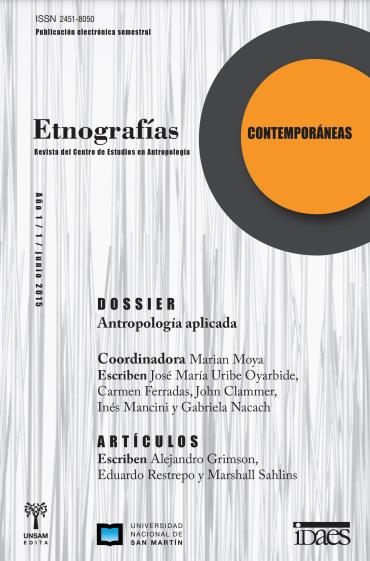Applied Anthropology, Art and Economy: investigating and planning cultural economy initiatives among South Asian tribal communities
Keywords:
art, creative economy, IndiaAbstract
This paper examines two cases of anthropological work among two tribal communities in eastern India in which cooperative work between an anthropologist and an artist was aimed at preserving and enhancing local visual and performing arts traditions, encouraging art work as an imagination-building exercise, and stimulating art and craft production as a means of creating an economic base for rural women. Research and sensitivity towards social structure, religion and traditional symbolism, the local political arrangements and distribution of power, gender, and the existing economy were necessary ingredients in proposing new initiatives which while they had the potential to increase incomes could also be disruptive of social relationships.References
Anheier, Helmut y Yudhishthir Raj Isar (eds.) (2011). Heritage, Memory and Identity. Los Angeles y London, Sage.
Bartra, Eli (ed.) (2003). Crafting Gender: Women and Folk Art in Latin America and the Caribbean. Durham, NC y London, Duke University Press.
Bundgaard, Helle (1999). Indian Art Worlds in Contention: Local, Regional and National Discourses on Orissan Patta Paintings. Richmond, Curzon Press for the Nordic Institute of Asian Studies.
Clammer, John; Poirier, Sylvie y Schwimmer, Eric (eds.) (2004). Figured Worlds: Ontological Obstacles to Intercultural Relations. Toronto y London, Toronto University Press.
Crehan, Kate (2011). Community Art: An Anthropological Perspective. Oxford y New York, Berg.
Furer-Haimendorf, C. von (1982). The Tribes of India: The Struggle for Survival. Berkeley, University of California Press.
Gell, Alfred (1996). “Newcomers to the World of Goods: Consumption among the Muria Gonds”, en Appadurai, Arjun (ed.): The Social Life of Things: Commodities in Cultural Perspective. Cambridge, Cambridge University Press, pp.110-138.
Haverkort, Bertus; Hooft, Katrien‘t y Hiemstra, Wim (eds.) (2003). Ancient Roots, New Shoots: Endogenous Development in Practice. Leusden, ETC/Compas y London, Zed Books.
Huyler, Stephen (1981). “Folk Art in India Today”, en Gray, Basil (ed.): The Arts of India. Ithaca, NY, Cornell University Press, y Oxford, Phaidon Press, pp.191-201.
Mandal, Hrishikesh y Sarkar, Amitabha (eds.) (2013). Traditional Wisdom and Sustainable Living: A Study on the Indian Tribal Societies. New Delhi, Gyan Publishing House for the Anthropological Survey of India.
Miner, Dylan (2015). Indigenous Aesthetics: Art, Activism and Autonomy. London, Bloomsbury.
Mitter, Partha (2007). The Triumph of Modernism: Indian Artists and the Avant-garde, 1922-1947. New Delhi, Oxford University Press.
Munn, Nancy (1971). “The transformation of subjects into objects in Walbiri and Pitjantjatjara myth”, en Berndt, R. (ed.): Australian Aboriginal Anthropology. Nedlands: University of Western Australia Press, pp.141-163.
Olivier de Sardin, Jean-Pierre (2005). Anthropology and Development: Understanding Contemporary Social Change. London y New York, Zed Books.
Ryan, Judith (1989). Mythscapes: Aboriginal Art of the Desert. Melbourne, National Gallery of Australia.
Sillitoe, Paul; Bicker, Alan y Pottier, Johan (eds.) (2002). Participating in Development: Approaches to Indigenous Knowledge. London y New York, Routledge.
Siddhartha (2013). Rethinking Festivals for Social and Ecological Engagement. Bangalore, Meeting Rivers.
UNESCO (2003). Second Proclamation of Masterpieces of Oral and Intangible Heritage of Humanity. Paris, United Nations Educational, Scientific and Cultural Organization.
UNESCO/UNDP (2013). Creative Economy Report 2013: Widening Local Development Pathways. New York, United Nations Development Programme, y Paris, UNESCO.
























